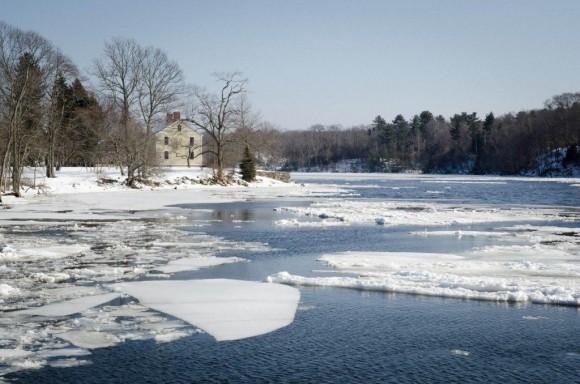
Last Friday was the perfect winter weather for a boat trip on the lower Connecticut River to view the wildlife and enjoy the experience of being one of the very few boats on the river during mid-February. I was a guest aboard the 65 ft. Project Oceanology vessel Enviro-Lab III for one of the “Eagle Watch” boat trips offered by Connecticut River Museum in partnership with Project Oceanology during February and March each year. This is the fourth season the Connecticut River Museum has teamed up with the Groton-based marine science and environmental education organization, Project Oceanology, to provide a dynamic on-water experience.
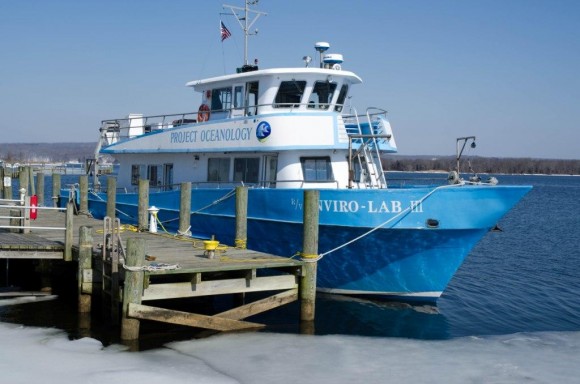
Although visitors to the river in winter can see many interesting avian species, the bald eagle is the one most visitors hope to see. Declared an endangered species in 1973 with the passage of the federal Endangered Species Act, populations began to recover following the ban on DDT, and by 2007, the bald eagle populations had recovered to the extent that they have now been removed from the endangered species list. They are, however, still protected on the federal level by the Bald Eagle and Golden Eagle Protection Act of 1940 and the Migratory Bird Treaty Act of 1918.
Every winter a number of bald eagles migrate south looking for open water to feed as the lakes and rivers in Canada and northern New England freeze. Many of these birds stop in Connecticut and winter along major rivers and large reservoirs, and can been seen feeding and occasionally nesting on the banks of the Connecticut river.
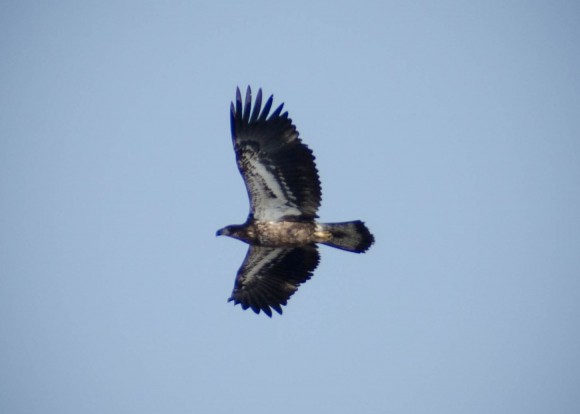
Although a sighting is not guaranteed, eagles are spotted on most trips. On the first trip of the season, six adult eagles and eight juveniles were spotted. On this trip, we were fortunate to spot our first young eagle soaring high above the boat minutes after casting off from the town dock as the boat headed north up river and then we saw several more eagles throughout the trip, some roosting in riverside trees and some gracefully circling above the river.
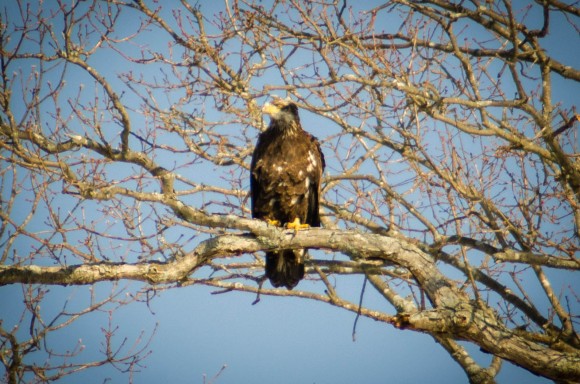
Eagles nesting on Nott Island
One of the highlights of the trip was to observe, from a distance, the rare sight of an eagle on her nest on the eastern side on Nott island, just across the river from Essex harbor. In the 1950s the bald eagle was no longer a nesting species in Connecticut but, according to the CT Department of Energy and Environmental Protection, in 1992 the state documented its first successful nesting of bald eagles since the 1950s when a pair raised two young birds in Litchfield County. Since then, the nesting population has increased gradually and, in 2010, 18 pairs of bald eagles made nesting attempts in the state.
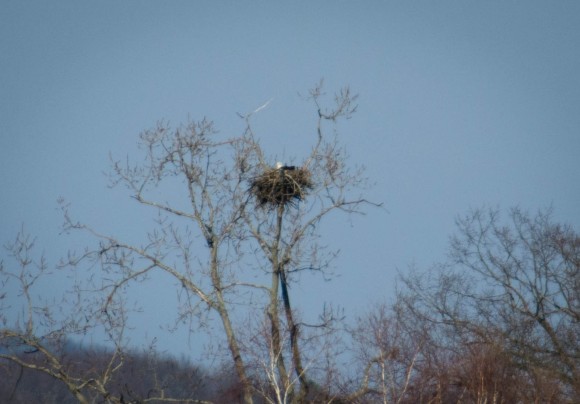
One such nesting pair is seen above on Nott Island. The female was about to lay her eggs a week or so ago but was temporarily disrupted by Winter Storm Charlotte. Hopefully, now that she is back on her nest, the eggs have been successfully produced.
“Let’s go out on the river and have some fun!”
The Eagle Watch boat trips are led by local expert naturalist and lecturer Bill Yule, who is an educator at the Connecticut River Museum. He is not only an expert on most wildlife species found along the Connecticut River but also a renowned expert on local mushrooms and fungi. Yule welcomed visitors aboard the trip with the invitation, “Let’s go out on the river and have some fun,” and throughout the trip he helped locate and identify birds, related historical stories about life along the river and made sure all the passengers were warm and comfortable with plenty of hot coffee.
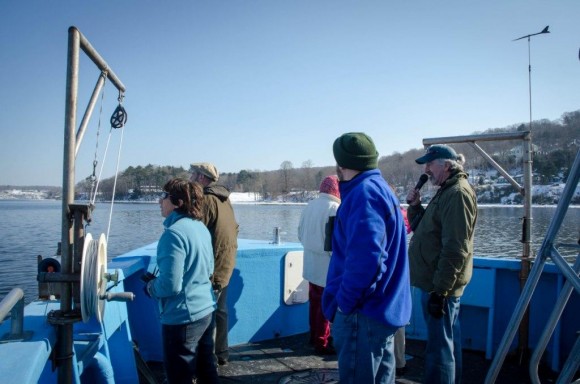
Yule was accompanied by two educators from Project Oceanology, Chris Dodge and Danielle Banco, who cheerfully helped identify interesting birds and assisted the boat captain with docking and navigating up and down the river between the ice flows.
Bald eagles are certainly not the only avian species guests can enjoy on the trip and on this particular voyage, we enjoyed numerous sightings of cormorants, black-backed gulls, red-tailed hawks and common merganser ducks.
We returned to the town dock some 90 minutes after departure excited by all the birds we had seen and moreover, educated about them, and, despite the cold, I am confident I am not the only traveler on that voyage who will be taking another trip later in the season. All in all, it was an awesome experience!
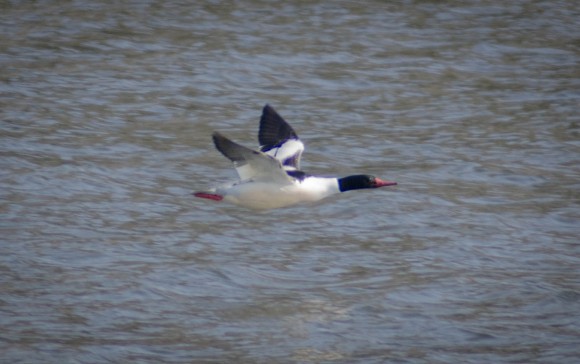
February Vacation Week Programs
The Connecticut River Museum is also offering a week-long program of vacation week activity for the February school break starting tomorrow, Feb. 19. In addition to an Eagle Watch adventure on Friday, Feb. 22, the program will also include a day exploring the many galleries in the museum, an outdoor exploration day including a nature hike and animal tracking, and an arts and crafts day building models boats, learning knot tying and other maritime arts.
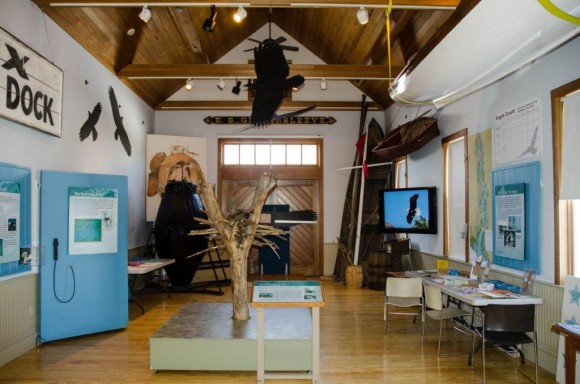
To make reservations for the vacation week program or for more information about Connecticut River Museum educational programs or Eagle Watch Tours, visit www.ctrivermuseum.org or contact Jennifer White Dobbs in the Education Department at jwhitedobbs@ctrivermuseum.org or Bill Yule, also in the Education Department, atbyule@ctrivermuseum.org.
Project Oceanology in Groton also offers Winter Seal Watch trips during weekends in February and March. These two and a half hour trips travel out into Fishers Island Sound to view these playful creatures, which are abundant in this area. The ticket price of $25 (adults) and $20 (children) also includes a 20-minute slide presentation.